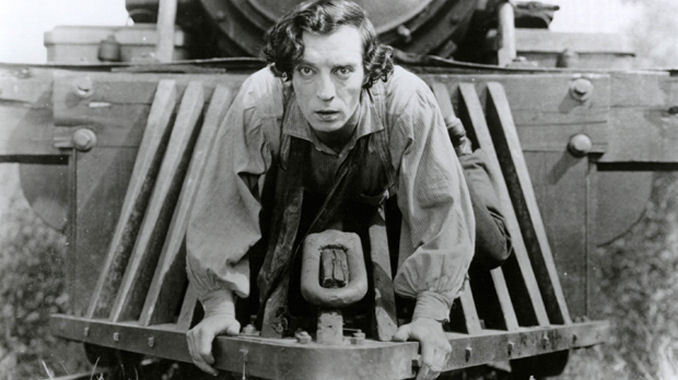



Members of the International Buster Keaton Society informally call themselves The Damfinos. Keaton reused the name for a racing shell in his 1927 film College. In their book Buster Keaton and the Muskegon Connection, Okkonen and Pesch assert that Keaton picked up the name from a powerboat entry in an Actors' Colony regatta in Muskegon, Michigan. As the name is referenced numerous times throughout the film, Oldham also describes it as "probably the longest running single pun in the history of the silent film". Oldham notes that the boat's name, Damfino (or "damn if I know") reflects Keaton's own reaction to the perplexing and challenging world he confronts in his films. The accompanying themes of calamity and destruction pave the way for the "little man" to regain control of the situation. The Boat is a classic retelling of Keaton's favorite theme of Man Versus Machine. "Where are we?" asks his wife (via an intertitle), to which Buster replies, "Damn if I know" (mouthing the words to the camera no intertitle is used). After wading a short distance, they come up on a deserted beach in the dark of night. Taking to a ridiculously small dinghy that is in fact a bathtub, the family resign themselves to sinking into the sea-until they realize they are actually standing in shallow water. The operator interprets it as "damn if I know" and dismisses the call as a prank.
#Best of buster keaton movies code#
He radios a Morse Code call for help, but when the Coast Guard operator asks who it is, he answers, "d-a-m-f-i-n-o" in Morse Code. The boat is barely seaworthy to begin with, and it does not help that Buster nails a picture up inside the boat, causing an improbable leak or when he further drills through the bottom of the boat to let the water out, resulting in a spectacular gusher. Once they're out on the Pacific, Buster and his family are caught in a terrible storm. The boat passes with impunity under the exceedingly low bridges of the Venice (California) canals thanks to Buster's clever boat design. When he attempts to launch the boat, Buster loses the family car. He enlarges the opening a bit, but when he tows the boat out using a pulley line from his Model T car, the boat proves to be a bit bigger than he estimated, and the house completely collapses. When he finishes and decides to take the boat out to sea, he realizes it is too large to fit through the door. He has built a large boat he has christened Damfino inside his home. The International Buster Keaton Society takes its name, The Damfinos, from the name of the film's boat.īuster is married with two children (both of whom wear child-sized versions of the same pork pie hat ). Contemporary reviews consider it one of his best shorts, with One Week (1920), The Playhouse (1921) and Cops (1922). A 2002 worldwide poll by Sight & Sound ranked Keaton's The General as the 15th best film of all time.The Boat is a 1921 American two-reel silent comedy film written and directed by, and starring Buster Keaton.
#Best of buster keaton movies series#
Critic Roger Ebert wrote of Keaton's "extraordinary period from 1920 to 1929, he worked without interruption on a series of films that make him, arguably, the greatest actor-director in the history of the movies." Orson Welles has stated his belief that Keaton's The General is the greatest comedy ever made, the greatest Civil War film ever made, and perhaps the greatest film ever made. In 1999, the American Film Institute ranked Keaton the 21st-greatest male actor of all time. Keaton was recognized as the seventh-greatest director of all time by Entertainment Weekly. He was best known for his silent films, in which his trademark was physical comedy with a consistently stoic, deadpan expression, earning him the nickname "The Great Stone Face". Joseph Frank Keaton, known professionally as Buster Keaton, was an American comic actor and filmmaker.


 0 kommentar(er)
0 kommentar(er)
